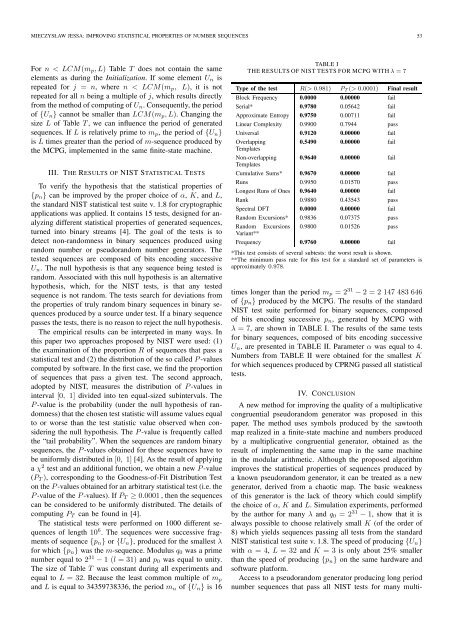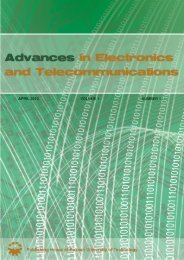november 2010 volume 1 number 2 - Advances in Electronics and ...
november 2010 volume 1 number 2 - Advances in Electronics and ...
november 2010 volume 1 number 2 - Advances in Electronics and ...
Create successful ePaper yourself
Turn your PDF publications into a flip-book with our unique Google optimized e-Paper software.
MIECZYSŁAW JESSA: IMPROVING STATISTICAL PROPERTIES OF NUMBER SEQUENCES 53<br />
For n < LCM(mp, L) Table T does not conta<strong>in</strong> the same<br />
elements as dur<strong>in</strong>g the Initialization. If some element Un is<br />
repeated for j = n, where n < LCM(mp, L), it is not<br />
repeated for all n be<strong>in</strong>g a multiple of j, which results directly<br />
fromthemethodofcomput<strong>in</strong>gof Un.Consequently,theperiod<br />
of {Un} cannot be smaller than LCM(mp, L). Chang<strong>in</strong>g the<br />
size L of Table T, we can <strong>in</strong>fluence the period of generated<br />
sequences. If L is relatively prime to mp, the period of {Un}<br />
is L times greater than the period of m-sequence produced by<br />
the MCPG, implemented <strong>in</strong> the same f<strong>in</strong>ite-state mach<strong>in</strong>e.<br />
III. THE RESULTS OF NIST STATISTICAL TESTS<br />
To verify the hypothesis that the statistical properties of<br />
{pn} can be improved by the proper choice of α, K, <strong>and</strong> L,<br />
the st<strong>and</strong>ard NIST statistical test suite v. 1.8 for cryptographic<br />
applications was applied. It conta<strong>in</strong>s 15 tests, designed for analyz<strong>in</strong>g<br />
different statistical properties of generated sequences,<br />
turned <strong>in</strong>to b<strong>in</strong>ary streams [4]. The goal of the tests is to<br />
detect non-r<strong>and</strong>omness <strong>in</strong> b<strong>in</strong>ary sequences produced us<strong>in</strong>g<br />
r<strong>and</strong>om <strong>number</strong> or pseudor<strong>and</strong>om <strong>number</strong> generators. The<br />
tested sequences are composed of bits encod<strong>in</strong>g successive<br />
Un. The null hypothesis is that any sequence be<strong>in</strong>g tested is<br />
r<strong>and</strong>om. Associated with this null hypothesis is an alternative<br />
hypothesis, which, for the NIST tests, is that any tested<br />
sequence is not r<strong>and</strong>om. The tests search for deviations from<br />
the properties of truly r<strong>and</strong>om b<strong>in</strong>ary sequences <strong>in</strong> b<strong>in</strong>ary sequences<br />
produced by a source under test. If a b<strong>in</strong>ary sequence<br />
passes thetests, thereis noreasonto reject thenull hypothesis.<br />
The empirical results can be <strong>in</strong>terpreted <strong>in</strong> many ways. In<br />
this paper two approaches proposed by NIST were used: (1)<br />
the exam<strong>in</strong>ation of the proportion R of sequences that pass a<br />
statistical test <strong>and</strong> (2)the distributionof the so called P-values<br />
computed by software. In the first case, we f<strong>in</strong>d the proportion<br />
of sequences that pass a given test. The second approach,<br />
adopted by NIST, measures the distribution of P-values <strong>in</strong><br />
<strong>in</strong>terval [0, 1] divided <strong>in</strong>to ten equal-sized sub<strong>in</strong>tervals. The<br />
P-value is the probability (under the null hypothesis of r<strong>and</strong>omness)thatthechosentest<br />
statistic will assumevaluesequal<br />
to or worse than the test statistic value observed when consider<strong>in</strong>g<br />
the null hypothesis. The P-value is frequently called<br />
the “tail probability”. When the sequences are r<strong>and</strong>om b<strong>in</strong>ary<br />
sequences, the P-values obta<strong>in</strong>ed for these sequences have to<br />
be uniformlydistributed<strong>in</strong> [0, 1] [4]. As the result of apply<strong>in</strong>g<br />
a χ 2 test <strong>and</strong> an additional function, we obta<strong>in</strong> a new P-value<br />
(PT ), correspond<strong>in</strong>g to the Goodness-of-Fit Distribution Test<br />
onthe P-valuesobta<strong>in</strong>edforanarbitrarystatistical test(i.e.the<br />
P-value of the P-values).If PT ≥ 0.0001,then the sequences<br />
can be considered to be uniformly distributed. The details of<br />
comput<strong>in</strong>g PT can be found <strong>in</strong> [4].<br />
The statistical tests were performed on 1000 different sequences<br />
of length 10 6 . The sequences were successive fragments<br />
of sequence {pn} or {Un}, produced for the smallest λ<br />
for which {pn} was the m-sequence. Modulus q0 was a prime<br />
<strong>number</strong> equal to 2 31 − 1 (l = 31) <strong>and</strong> p0 was equal to unity.<br />
The size of Table T was constant dur<strong>in</strong>g all experiments <strong>and</strong><br />
equal to L = 32. Because the least common multiple of mp<br />
<strong>and</strong> L is equal to 34359738336, the period mu of {Un} is 16<br />
TABLE I<br />
THE RESULTSOF NIST TESTSFOR MCPG WITH λ = 7<br />
Type of the test R(> 0.981) PT (> 0.0001) F<strong>in</strong>al result<br />
Block Frequency 0.0000 0.00000 fail<br />
Serial* 0.9780 0.05642 fail<br />
Approximate Entropy 0.9750 0.00711 fail<br />
L<strong>in</strong>ear Complexity 0.9900 0.7944 pass<br />
Universal 0.9120 0.00000 fail<br />
Overlapp<strong>in</strong>g<br />
Templates<br />
0.5490 0.00000 fail<br />
Non-overlapp<strong>in</strong>g<br />
Templates<br />
0.9640 0.00000 fail<br />
Cumulative Sums* 0.9670 0.00000 fail<br />
Runs 0.9950 0.01570 pass<br />
Longest Runs of Ones 0.9640 0.00000 fail<br />
Rank 0.9880 0.43543 pass<br />
Spectral DFT 0.0000 0.00000 fail<br />
R<strong>and</strong>om Excursions* 0.9836 0.07375 pass<br />
R<strong>and</strong>om Excursions<br />
Variant**<br />
0.9800 0.01526 pass<br />
Frequency 0.9760 0.00000 fail<br />
*This test consists of several subtests: the worst result is shown.<br />
**The m<strong>in</strong>imum pass rate for this test for a st<strong>and</strong>ard set of parameters is<br />
approximately 0.978.<br />
times longer than the period mp = 2 31 − 2 = 2 147 483 646<br />
of {pn} produced by the MCPG. The results of the st<strong>and</strong>ard<br />
NIST test suite performed for b<strong>in</strong>ary sequences, composed<br />
of bits encod<strong>in</strong>g successive pn, generated by MCPG with<br />
λ = 7, are shown <strong>in</strong> TABLE I. The results of the same tests<br />
for b<strong>in</strong>ary sequences, composed of bits encod<strong>in</strong>g successive<br />
Un, are presented <strong>in</strong> TABLE II. Parameter α was equal to 4.<br />
Numbers from TABLE II were obta<strong>in</strong>ed for the smallest K<br />
forwhichsequencesproducedbyCPRNG passedall statistical<br />
tests.<br />
IV. CONCLUSION<br />
A new method for improv<strong>in</strong>g the quality of a multiplicative<br />
congruential pseudor<strong>and</strong>om generator was proposed <strong>in</strong> this<br />
paper. The method uses symbols produced by the sawtooth<br />
map realized <strong>in</strong> a f<strong>in</strong>ite-state mach<strong>in</strong>e <strong>and</strong> <strong>number</strong>s produced<br />
by a multiplicative congruential generator, obta<strong>in</strong>ed as the<br />
result of implement<strong>in</strong>g the same map <strong>in</strong> the same mach<strong>in</strong>e<br />
<strong>in</strong> the modular arithmetic. Although the proposed algorithm<br />
improves the statistical properties of sequences produced by<br />
a known pseudor<strong>and</strong>om generator, it can be treated as a new<br />
generator, derived from a chaotic map. The basic weakness<br />
of this generator is the lack of theory which could simplify<br />
the choice of α, K <strong>and</strong> L. Simulation experiments, performed<br />
by the author for many λ <strong>and</strong> q0 = 2 31 − 1, show that it is<br />
always possible to choose relatively small K (of the order of<br />
8) which yields sequences pass<strong>in</strong>g all tests from the st<strong>and</strong>ard<br />
NIST statistical test suite v. 1.8. The speed of produc<strong>in</strong>g {Un}<br />
with α = 4, L = 32 <strong>and</strong> K = 3 is only about 25% smaller<br />
than the speed of produc<strong>in</strong>g {pn} on the same hardware <strong>and</strong><br />
software platform.<br />
Access to a pseudor<strong>and</strong>om generator produc<strong>in</strong>g long period<br />
<strong>number</strong> sequences that pass all NIST tests for many multi-







